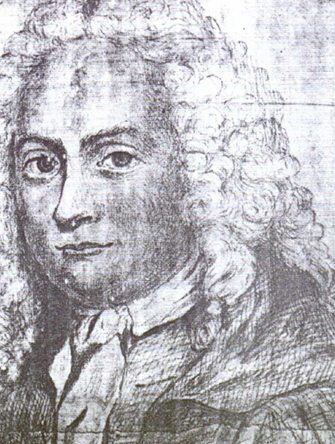From Colin Mac Laurin to Sir Martin Folkes (1058) 30. June 1743.
Presented Nov. 3 1732
 Colin Maclaurin
Born: Feb 1698 in Kilmodan , Cowal, Argyllshire, Scotland
Died: 14 June 1746 in Edinburgh, Scotland
Colin Maclaurin
Born: Feb 1698 in Kilmodan , Cowal, Argyllshire, Scotland
Died: 14 June 1746 in Edinburgh, Scotland
The Sagacity of the Bees in making their Cells of an
hexagonal Form, has been admired of old, and that
figure has been taken notice of, as the best they could
have pitched upon for their Purposes : but a yet more surprising Instance of the
Geometry of these little Insects is seen in the form of the Bases of those Cells,
discoverd in the late accurate Observations of Monsr Maraldi and Monsr de
Reaumur, who have found those Bases to be of that Pyramidal figure, that
requires the least Wax for containing the same Quantity of Honey, and which
has at the same time, a very remarkable Regularity and Beauty, connected of
Necessity with its Frugality.
These Bases are formed from three equal Rhombus's, the obtuse Angles of
which are found to be the doubles of an Angle that often offers it self to Mathematicians in Questions relating to Maxima and Minima; that is the Angle whose
Tangent is to the Radius, as the Diagonal is to the Side of the Square.(1059)
By
this Construction, of the six solid Angles at the Base that correspond in the
Angles of the Hexagon, three are equal as well to each other, as to the solid
Angle at the Apex of the Figure, each of which solid Angles is respectively
formed from three equal plane obtuse Angles : and the other three solid Angles
are also equal to each other, but severally formed each from four equal plane
acute Angles, Supplements to the former obtuse Ones.
By this form the utmost Improvement is made of their Wax, of which they
are on all occasions very saving, the greatest Regularity is obtaind in the Construction, and with a particular Facility in the Execution, as there is one sort of
Angle only with its Supplement, that is required in the Structure of the whole
Figure.
*Monsr Maraldi, had found by Mensuration that the obtuse Angles of the
Rhombus's, were of 110 Degrees nearly, upon which he observed that if the
three obtuse Angles which formed the solid Angles above-mention'd were
supposed equal to each other, they must each be of 109°:28'; from whence it
has been inferrd that this last was really the true and just measure of them : and
lately Monsr de ** Reaumur has informed us, that Mr Kočnig having at his desire
sought what should be the Quantity to be given to this Angle, in order to employ
the Least Wax possible in a Cell of the same Capacity, that Gentleman had found, by a higher Geometry
than was known to the Antients, by the Method of Infinitesimals, that the Angle in question,
ought in this Case to be of 109°:26'
----------------------------------------
(1058) This MS. is a copy of part of the originai letter and was published as [54]. The
original letter is lost.
(1059) i.e. the angle whose tangeni is 1.4142. This angle is 54°44', giving the double-angle
of 109° 28' mentioned below.
* Memoires de I Acad. des Sciencee 1712.
* * Memoires sur les Insectes Tom V
From Colin Mac Laurin to Sir Martin Folkes (1058) 30. June 1743.
Presented Nov. 3 1732The collected letters of Colin Mac Laurin
edited by Stella Mills University of Birmingham Shiva Plubbishing Limited pp 386-391

 Colin Maclaurin
Born: Feb 1698 in Kilmodan , Cowal, Argyllshire, Scotland
Died: 14 June 1746 in Edinburgh, Scotland
Colin Maclaurin
Born: Feb 1698 in Kilmodan , Cowal, Argyllshire, Scotland
Died: 14 June 1746 in Edinburgh, Scotland 